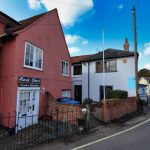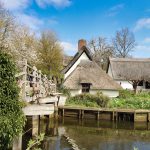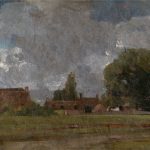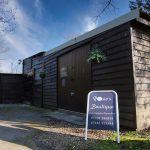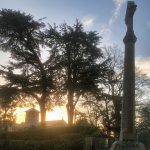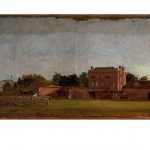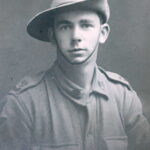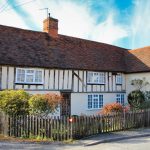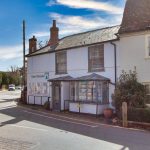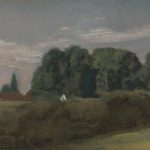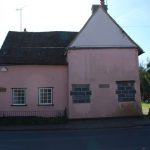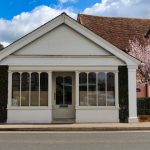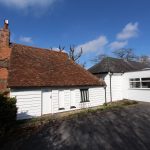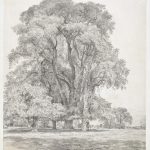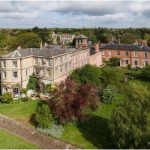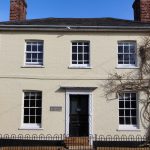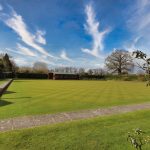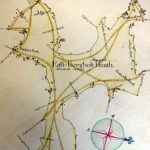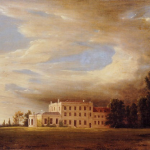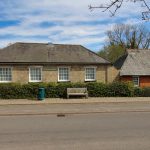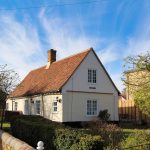Sydney was living in Ipswich when he volunteered to join the Army in November 1914. He served with 1st Battalion of the Suffolk Regiment and was wounded during The Second Battle of Ypres. Sydney died of his wounds in hospital in Boulogne.
Ladies clothing, bags and accessories
Wednesday-Friday 1000-1500 | Saturday 1000-1300
Bridge Cottage was depicted in many of John Constables paintings of Flatford, and dates from around 1700, however no doubt there were other buildings on the site prior to this.
By the 19th century, it was converted into two dwellings, each family lived with a small parlous with access to a single bedroom in the attic, accessed in one by a twisting staircase, and the other a loft ladder.
The stand of trees and the lone poplar tree on the right make it clear that this view is that of the rear of East Bergholt House, the property built by Golding Constable in 1774, the artist's family home.
Brother of Max Clifton. Fred volunteered to join the Royal Fusiliers shortly after the outbreak of War and was wounded during the Gallipoli Campaign in 1915. He later served on the Western Front before being killed during the Battle of Arras.
Monday | Weds | Friday
1000-1400
Saturday
1000-1300
On the 24th February 1909, local newspapers reported a story with the headlines ‘Runaway Nun: Escape from East Bergholt Convent, Struggle with Pursuers’!
A panoramic view of Constable’s family home, East Bergholt House, built by John's father, Golding Constable, in the late 1700’s and where the family lived until 1819. After selling it to a family friend it fell into disrepair and was demolished c1840
Brother of Fred Clifton. Having emigrated to Australia before the War, Max volunteered to join the Australian Imperial Force in 1915. He served at Gallipoli and later on the Western Front.
Constable was deeply attached to his birthplace, East Bergholt House, which his father had built when Flatford Mill became too small for his growing family. Although the house was pulled down c1840, the stable block and outbuildings survive
Arthur joined the Royal Navy at the age of 18 and for his service before 1914 had been awarded the Naval Long Service and Good Conduct Medal and also a campaign medal. He was killed in 1916, during the Battle of Jutland, leaving a wife and young son.
Named after Mr Edward Lambe, Lord of the Manor of "Illaries, (the Illaries manor house was the site of Manor Farm, East End), the Lambe School served as a school house for the village for many years.
It was restored by East Bergholt Society in 1974, and is now available for hire for Weddings, Meetings, Social gatherings etc. One regular monthly event is the Saturday East Bergholt "Farmers Market" for local produce.
Old Hall, East Bergholt,
pencil with slight grey and white washes, 1817, Victoria and Albert Museum
The earliest records date back to only the 14th Century and by which time Old Hall was established on its present site. Having been owned by Norman knights, wealthy Earls of Oxford, by London bankers and country squires, by staunch Puritans and Catholic religious orders, by soldiers in transit and now since 1974 The Old Hall Community.
Having worked before the war as a Horseman on a farm, Frank volunteered to join the Cavalry in 1914. He was transferred to the Infantry before being sent overseas where he served in Flanders with 2nd Battalion of the Suffolk Regiment.
East Bergholt village Cricket Club
parking available
Lawn bowls club situated at the far side of Constable Hall playing Fields.
parking available
Throughout the medieval (and postmedieval periods) the central part of the parish was dominated by an extensive area of open heathland (East Bergholt Heath), criss-crossed by trackways leading to Dodnash Priory, Brantham, Flatford and Wenham.
A magnificent example of Constable's earlier work, commissioned by John Reade, Lord of Old Hall Manor from 1801
Arthur served in the Machine Gun Corps (nicknamed “The Suicide Club”, due to its high casualty rates) on the Western Front. He was killed in action in during the Battle of the Somme, in September 1916.
Located at the far end of the Constable Hall playing fields.
parking available



